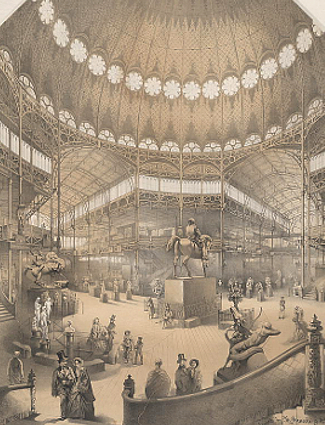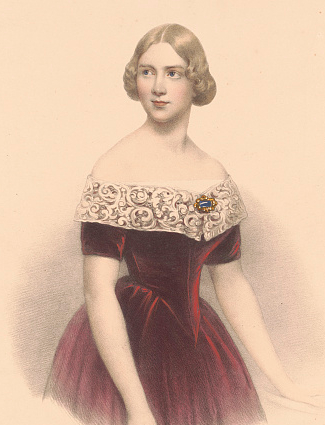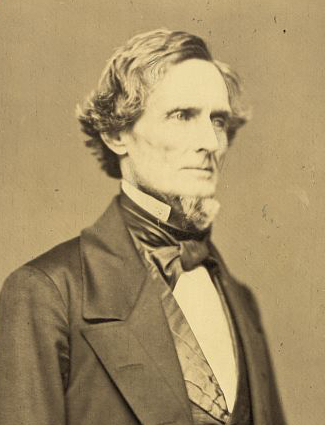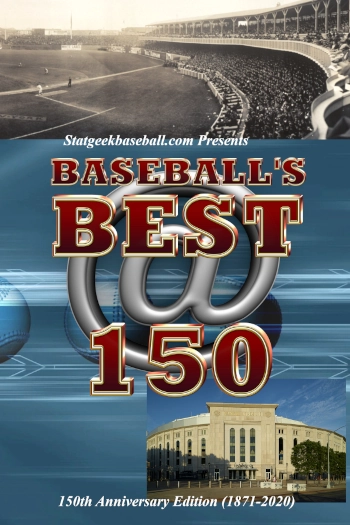
NEW YORK, UNITED STATES 1853-4
The Exhibition of the Industries of All Nations
Sponsor this page. Your banner or text ad can fill the space above.
Click here to Sponsor the page and how to reserve your ad.
Quick List Info

Dates Open - 1853 Season: Opening Day - July 14, 1853 (Thursday). Open July 15 to November 30, 1853. Open some days in December.
Open from Jan. 1, 1854 to April 15, 1854. Closed from April 15 to May 3, 1854. Reopened May 4, 1854 (Thursday) to Nov. 1, 1854. (Not open Sundays in 1853, same probably true for 1854. Some sources state that closing day was October 30, 1854.
Attendance - 1853 season, 119 days - 696,965 . Total Attendance 1,250,000. (Some sources state 1,150,000.)
International Participants - 17 nations and 6 colonies/protectorates.
Total Cost - $891,070 (as of Dec. 1, 1853).
Site Acreage - Entire site within Bryant Park area covered 13 acres. The Exhibition building encompassed 6 acres.
Sanction and Type - Prior to the Bureau of International
Exhibitions. Due to its size, in today's vernacular, would be considered a Special Exhibition.
There was no official government backing for the exhibition, but President Franklin Pierce opened the fair and there was extensive foreign participation, both private and nations. The exhibit was a bonded warehouse.
Ticket Cost - Full price 50 cents with Season Ticket $10. Average cost of ticket in 1853 - $0.47 (47 cents). Average cost of ticket in January 1854 - $0.44 (44 cents).
Photo top center: Exterior New York Crystal Palace, Industry of All Nations, lithograph by Nigel & Weingartner, Carl Emil Doepler, artist, 1852. Column Top: Interior New York Crystal Palace, Industry of All Nations, by Nigel & Weingartner, 1853. Both courtesy Library of Congress.
Minute Walk in History
After the success of London's 1st ever World Exhibition in 1851, other cities in the world started making plans for ones of their own. In the United States, the first was a two year fair known as the "The Exhibition of the Industries of All Nations." Take a trip around the site with narration from Jason Donovan and one of the songs played on opening day, "Hail to Columbia."

Other Histories of World's Fairs to Check Out
-
Quick List of All Expos
1st World's Fair in History
London 1851
Paris 1855
Paris 1889
St. Louis 1904
Paris 1937
New York 1939-40
Brussels 1958
New York 1964-5
- For
more info about the World's Fair Decision Model, development of the model, the study participants, etc. The development is currently being utilized for in-house publishing projects, but is not available for work-for-hire decuments or consulting.
- For More
info about the Bureau of International Exhibitions - Sanctioning body for international exposition (world's fairs) headquartered in Paris, France.
- For more
info about previous EXPOcheck reports.

1st World's Fair in History
London 1851
Paris 1855
Paris 1889
St. Louis 1904
Paris 1937
New York 1939-40
Brussels 1958
New York 1964-5
History of the Event

The Great Exhibition of All Industries had been such a success for Great Britain with London 1851 that various nations around the world began contemplating hosting one of their own. In New York City, a private company that had attended the London fair began to organize, raising capital stock of $459,000 and leasing acreage in Reservoir Square, at the rear of today's New York Public Library, from the city for $1 per year from January of 1853 until December 1857. They erected an Exhibition Building, which took longer than expected, and invited participants (four thousand, eight hundred and fifty-four would come with half from foreign nations). The exhibition building had the appearance of a greenhouse with Moorish architecture. The event was not a financial success with the loss borne by the private firm. Many blamed the slow construction which missed their intended opening day of May 1, as well as the incomplete state of affairs through September 1853. Once the first season closed, the organizers convinced P.T. Barnum, who had eschewed involvement in the first year, to take over the second. He lasted four months, but did bring additional attractions to the event, including the Swedish Nightingale, Jenny Lind (above), and Tom Thumb (below).
Above photo. Jenny Lind, drawing on stone, by Richard James Lane, 1847. Below: Lithograph of Tom Thumb, by N. Currier, 1849. Courtesy Library of Congress.

The exhibition building was two stories and three hundred and sixty-five feet in diameter. It had a one hundred foot high dome that was three hundred and sixty-five feet high. It was designed by George Castenson and Charles Geldmeister. The main building covered 170,000 sq. ft with a 93,000 sq. ft. annex. Construction started in October 1852. Two railroads ran by the site, providing transportation for visitors.
The opening ceremony on July 14, 1853 included pomp and circumstance with President Franklin Pierce in attendance. At two o'clock, the band began playing Hail Columbia and Yankee Doodle. Later that night at a dinner reception, Secretary of War and future President of the Confederate States of America, Jefferson Davis, gave a speech. Seven thousand attended opening day; three thousand four hundred and fifty people paid. Other dignitaries at the opening; Salmon P. Chase and Winfield Scott.
Exhibits at the world's fair included Eli Otis with his elevator, the sewing machine, exhibits from various foreign nations, and a bearded lady. There were thirty-one classes of exhibits with the Mineral Department deemed most interesting by the New York Times. Of the space taken by nations, the United States took the bulk (54,530 of 98,749 square feet). During the second season with P.T. Barnum involved, the exhibition attracted even more circus style performers, including Lind, Thumb, and Siamese Twins.
Other causes for failure: The lack of United States government backing caused inter-state jealousy from cities that wanted to host, and then refused to participate. The roof leaked.

First U.S. World's Fair

International Participants
Nations and Colonies
Gr. Britain & Ireland, Mexico, West. Indies (C), Germany (Prussia), Turkey, Prince Edward Isle (C), Belgium, Haiti, Nova Scotia (C), France, British Guiana (C), Switzerland, Canada (C), Holland, United States, Austria, Denmark, Italy, Newfoundland (C), Sweden, Germany (Zollverein), Norway, and Russia.
Season Tickets
Price: $10
Expo Tidbits
Original site of exhibition was Madison Square, but opposition to that site forced a move.
Was first World's Fair to have a picture gallery.
Population of New York City in 1853 was 600,000.
Credited with spurring the idea of police uniforms for New York City policeman.
Beginning in 1855, building housed the annual fairs of the American Institute and was the scene of charity balls.
Building was used for various functions until October 5, 1858 when a fire destroyed it.
Legacies
Now site of Bryant Park.
New York Public Library next door to site.
Those in Charge

Organizers for the 1853 season included Horace Greeley, Theodore Sedgwick, Alfred Pell, and New York businessman Edward Riddle, who had been one of the American commissioners to the London fair. Greeley was put in prison in France after the fair due to a suit brought by a French exhibitor whose goods had been damaged. Jefferson Davis, Secretary of War, was a participant during the opening day.
Sources: Statement of the Affairs for the Exhibition of All Nations, as of Feb. 2, 1854; New York Times; London Times; The New York Crystal Palace: An International Exhibition of Goods and Ideas by Thomas Gordon Jayne; Historical Dictionary of World's Fairs by Alfred Heller; Footsteps at the American World's Fairs by Stanley K. Hunter; Bulletin of the New York Public Library, Sept. 1960, Volume 64, Number 9, The Exhibition in the Palace, A Bibliographical Essay, Earle E. Coleman, Longwood Library.
Photo column top: P.T. Barnum, by Charles D. Fredericks and Co., 1860-1864. Bottom: Jefferson Davis, by Matthew B. Brady, 1858-1860. Courtesy Library of Congress.

Price: $10
Original site of exhibition was Madison Square, but opposition to that site forced a move.
Was first World's Fair to have a picture gallery.
Population of New York City in 1853 was 600,000.
Credited with spurring the idea of police uniforms for New York City policeman.
Beginning in 1855, building housed the annual fairs of the American Institute and was the scene of charity balls.
Building was used for various functions until October 5, 1858 when a fire destroyed it.
Now site of Bryant Park.
New York Public Library next door to site.

Sources: Statement of the Affairs for the Exhibition of All Nations, as of Feb. 2, 1854; New York Times; London Times; The New York Crystal Palace: An International Exhibition of Goods and Ideas by Thomas Gordon Jayne; Historical Dictionary of World's Fairs by Alfred Heller; Footsteps at the American World's Fairs by Stanley K. Hunter; Bulletin of the New York Public Library, Sept. 1960, Volume 64, Number 9, The Exhibition in the Palace, A Bibliographical Essay, Earle E. Coleman, Longwood Library.
Photo column top: P.T. Barnum, by Charles D. Fredericks and Co., 1860-1864. Bottom: Jefferson Davis, by Matthew B. Brady, 1858-1860. Courtesy Library of Congress.

History of America
Check out our partners at America's Best History for the history of the United States. Great for students of history or just those that want to find out a little more about the whats, when, wheres, and how of heritage tourism.

To the 1890s
Baseball Stat Books

-
Baseball's Best @ 150
Baseball's Best @ 150, the book that counts down the best players, pitchers, and fielders on the 150th anniversary of Major League Baseball (1871-2020).
-

-
Fields of Gold, Baseball's Best Glove Work
The newest book in the Stat Geek Baseball universe. Fields of Gold, Baseball's Best Glove Work. It's what the Best Ever Book was for hitting and pitching, but now a detailed look at the Best Fielders in Baseball History, including best position players for every team, and best overall for every position